A Study on Industrial Heritage Renewal Strategy Based on Hybrid Bayesian Network
Abstract
1. Introduction
- Summarize the latest research findings on industrial heritage in China and other countries;
- Scientifically and quantitatively analyze the development prospects of industrial heritage in the context of sustainable development;
- Develop a novel hybrid model for regeneration studies that specifically caters to all types of industrial heritage through an in-depth exploration of multiple research methods and techniques.
2. Materials and Methods
2.1. Literature Review
2.1.1. Industrial Heritage
2.1.2. Bayesian Network
2.2. Determine Intermediate Nodes
2.3. Determine Leaf Nodes—Field Investigation
2.3.1. Urban Planning (B6)
2.3.2. Surrounding Resources (B2)—Initial Sample Selection
- Selection of Geographic Location: Various geographic locations are available for consideration. In line with the overarching focus on sustainable development, the chosen geographic location disregards geological, geomorphological, and locational information, instead prioritizing the city’s developmental trajectory. The rapid advancements witnessed in first-tier cities hold significant guidance for informing the sustainable progression of other urban areas. Therefore, we tried to identify suitable samples from first-tier Chinese cities: Beijing, Shanghai, Guangzhou, and Shenzhen. In addition, we wanted to select a city that has experienced significant growth in the past decade, even if it is not a provincial capital or a first-tier city. After evaluating city rankings and GDP rankings in China over the previous decade, we found that Wenzhou in Zhejiang Province is an optimal choice. Formerly classified as a third-tier city, Wenzhou garnered recognition as the most promising third-tier city after 2015. By 2020, Wenzhou ascended to the status of a second-tier city, securing the ninth position in city rankings. Consequently, this study elected the representative industrial heritage project from each of these five cities as a sample. Additionally, these five samples must meet specific requirements regarding completion time and industrial category.
- Construction Period: The chosen set of five projects comprehensively encompasses the historical timeline of China’s industrial development, spanning ancient, modern, and contemporary eras following the establishment of the country.
- Industrial Categories: The selected five projects represent a wide spectrum of industrial categories, ranging from early extractive industries to subsequent heavy and light industries. These categories effectively cover the diverse facets of China’s industrial category.
2.3.3. Validation Case: Current Status of the Former Site Museum of Changchun Film Studio (CFS)
2.4. Experimental Method
- First, we analyzed keywords in the literature pertaining to industrial heritage, urban renewal, heritage renewal, and related fields using CiteSpace software and conducting a literature review. The initial analysis aimed to discern the demand for industrial heritage renewal forms and identify the principal influential factors in the context of sustainable development and establish intermediate nodes B1–B6.
- Second, the intermediate nodes of “Location”, “Structural Style”, and “Sustainable Development” can be determined based on expert opinions, providing general content. Additionally, the leaf nodes of “Urban Planning” are derived from the development planning requirements of select first-tier cities in China.
- Third, for “Surrounding Resources”, a questionnaire and face-to-face interviews are conducted to select projects in China that represent the historical and industrial categories of the country’s industrial heritage. These projects serve as initial sample data to develop the root nodes for training the hybrid model. Then, we obtain the POI data around the research object and the total POI data under the related industry classification of the whole city and combine the kernel density analysis method to analyze the proportion of data of different fields in the city.
- Fourth, the leaf nodes of “Surrounding Residents” are obtained through a questionnaire conducted among residents residing in proximity to the target. This survey aims to gain insights into the future needs of the residents and explore the anticipated trends in user requirements over the next 15–25 years.
- Fifth, we review literature related to the AHP analytical hierarchy method and combine it with expert industry guidance to determine whether the AHP method can be employed to investigate the 6 intermediate nodes and 10 root nodes in the Bayesian model.
- Sixth, we create a comprehensive innovative BN-POI-AHP hybrid Bayesian network model.
- Seventh, taking the Former Site Museum of Changchun Film Studio (CFS) as a case study, the questionnaire and face-to-face interviews data collected from the surrounding residents and the data on surrounding POI are incorporated into the hybrid Bayesian network model. Then, the strengths and weaknesses of the hybrid model are evaluated.
- Finally, based on the experimental data from the case study and combined with the literature survey method, an analysis is conducted to examine the development prospects and limitations of the BN-POI-AHP hybrid Bayesian network model.
2.4.1. Face-to-Face Interviews
- Initially, we refined the questionnaire information based on the primary research purpose and content of this study. This step facilitated the determination of relevant items in the questionnaire survey. It was assessed by industry experts for the accuracy and representativeness of the question items.
- Next, we defined the scope of the survey respondents, considering variables such as residential districts and age ranges.
- Subsequently, we disseminated and collected questionnaires to ensure a sufficient number of valid responses, and used face-to-face surveys for those who were too old to finish the questionnaire alone.
- Finally, we systematically organized and analyzed the collected questionnaire data.
2.4.2. POI Data Extraction
- Step 1: Process POI data
- Step 2: Kernel density analysis
- Step 3: Validate the data
- Step 4: Normalization process
2.4.3. Analytical Hierarchy Process Method
- Evaluate pairwise comparisons of criteria: for each pair of criteria, it is necessary to determine which criterion is more important. With the input of industry experts (including middle and senior engineers from planning or architectural design institutes and professors of architecture-related majors in universities in Changchun), we determined the roles and levels of importance of each index in the industrial heritage renewal strategy. We then constructed each index layer and performed pairwise comparisons. The values within pairwise comparisons of criteria were shown in Table 8 [91].
- Develop judgment matrices: After pairwise comparisons have been made for all pairs of criteria, judgment matrices need to be developed. The data were subsequently divided into four groups, and the corresponding judgment matrices were created based on pairwise comparisons.
- Calculate criteria weights: After all judgment matrices are developed, it is necessary to calculate the weight of each criterion. The judgment matrices must be transformed to obtain the numerical values of the weighting indicators. For this, the eigenvalue of the judgment matrices and the priority vector are used.
- Check consistency: It is important to check the consistency of the obtained results using the consistency ratio. This can prove the validity of the data.
2.4.4. Bayesian Network
3. Analysis and Discussion
3.1. Quantitative Analysis of the AHP Method
- Step 1: Develop Judgment Matrices
- Step 2: Calculate criteria weights
- Step 3: Consistency Test for the Data Results
3.2. Created the BN-POI-AHP Hybrid Bayesian Network Model
- Step 1: Build the hybrid model.
- Step 2: Training the model.
3.3. Case Proof
3.3.1. Quantitative Analysis of the Face-to-Face Interviews
3.3.2. Quantitative Analysis of POIs
3.4. Discussion
- The BN-POI-AHP hybrid Bayesian network model developed in this research, although capable of providing an initial determination of the update direction, is not yet comprehensive enough to encompass all the influencing factors. There is a need for further improvement in terms of accuracy.
- During the data acquisition stage of this study, there may be a minor presence of errors. These errors have been identified through industry expert assessments and specific validation methods, and they have almost no impact on the final results. However, it is important to acknowledge that data errors remain a challenge that should not be overlooked in future in-depth investigations.
- In an attempt to enhance the accuracy of the model, the BN-POI-AHP hybrid Bayesian network model created in this study integrates calculations and modeling techniques that are multidomain, and multimethod, and require the integration of multiple software platforms. However, this complexity poses a challenge for general decision-makers, as it necessitates time and effort to attain proficiency in these calculations and models. Therefore, perhaps they need the help of additional professional researchers.
4. Conclusions
- We utilized the Former Site Museum of CFS as an example to demonstrate the applicability of the BN-POI-AHP hybrid Bayesian network model across different projects, tailoring the renewal to each project’s distinct characteristics. This approach is underpinned by a “specialization” strategy. The hybrid model created in this research surpasses previous scholarly results in terms of objectivity, comprehensiveness, and specialization. Consequently, the feasibility of the BN-POI-AHP hybrid Bayesian network model, developed within the context of this research, is significant.
- According to the study’s findings, each of the proposed six intermediate nodes exerts a non-negligible direct or indirect impact on the industrial heritage renewal strategy.
- The BN-POI-AHP hybrid Bayesian network model enables the proposal of more targeted renewal strategies for each various project, considering the characteristics of the target project itself. On the one hand, it prioritizes sustainability and aligns with urban development needs; on the other hand, by objectively analyzing the data, we can assess the future development direction, predict residents’ needs, and reduce the risk of obsolescence over time. Therefore, we strongly believe that the BN-POI-AHP hybrid Bayesian network model provides both technological advancements and methodological approaches to industrial heritage renewal strategies, driving them toward compliance with the requirements of sustainable development.
- The research successfully realized the strategy and method of sustainable renewal of industrial heritage, from objective data collection to data modeling and the construction of rational proposals.
Author Contributions
Funding
Institutional Review Board Statement
Informed Consent Statement
Data Availability Statement
Acknowledgments
Conflicts of Interest
Abbreviations
| BN | Bayesian Network |
| HBNs | Hybrid Bayesian Networks |
| POI | Point of Interest |
| AHP | Analytic Hierarchy Process |
| CFS | Changchun Film Studio |
References
- World Heritage List Statistics. Available online: https://whc.unesco.org/en/list/stat (accessed on 1 June 2023).
- Notice of the Ministry of Industry and Information Technology of the People’s Republic of China on the Announcement of the First List of China’s Industrial Heritage. Available online: https://www.miit.gov.cn/zwgk/zcwj/wjfb/tg/art/2020/art_26f9f30006e449c5a082bbda09dd7952.html (accessed on 30 April 2023).
- Buchanan, R.A. History and Heritage: The Development of Industrial Archaeology in Britain; National Council on Public History, University of California Press: Berkeley, CA, USA, 1989; Volume 11. [Google Scholar]
- TICCIH. The Nizhny Tagil Charter for the Industrial Heritage. 2003. Available online: https://ticcih.org/wp-content/uploads/2013/04/NTagilCharter.pdf (accessed on 30 April 2023).
- Mieg, H.A.; Oevermann, H.; Cossons, N.; Cramer, J.; Ringbeck, B.; Watson, M. Discussing Industrial Heritage Conservation and Planning. In Industrial Heritage Sites in Transformation: Clash of Discourses; Routledge: New York, NY, USA, 2015; pp. 201–218. [Google Scholar]
- This Year’s IDMS Features the Following Theme: Heritage Changes. Available online: https://www.icomos.org/en/focus/18-april-international-day-for-monuments-and-sites/121522-18-april-2023-heritage-changes (accessed on 30 April 2023).
- Wilkinson, S.J.; Remøy, H.; Langston, C. Sustainable Building Adaptation: Innovations in Decision-Making; John Wiley & Sons: Chichester, UK, 2014. [Google Scholar]
- Harun, S.N. Heritage Building Conservation in Malaysia: Experience and Challenges. Procedia Eng. 2011, 20, 41–53. [Google Scholar] [CrossRef]
- Cano, M.; Garzón, E.; Sánchez-Soto, P. Historic preservation, GIS, & rural development: The case of Almería province, Spain. Appl. Geogr. 2013, 42, 34–47. [Google Scholar] [CrossRef]
- Ball, R. Developers, regeneration and sustainability issues in the reuse of vacant industrial buildings. Build. Res. Inf. 1999, 27, 140–148. [Google Scholar] [CrossRef]
- Fuentes, J.M.; Gallego, E.; García, A.I.; Ayuga, F. New uses for old traditional farm buildings: The case of the underground wine cellars in Spain. Land Use Policy 2010, 27, 738–748. [Google Scholar] [CrossRef]
- Chan, A.; Cheung, E.; Wong, I. Impacts of the Revitalizing Industrial Buildings (RIB) Scheme in Hong Kong. Sustain. Cities Soc. 2015, 19, 184–190. [Google Scholar] [CrossRef]
- Cyrenne, P.; Fenton, R.; Warbanski, J. Historic Buildings and Rehabilitation Expenditures: A Panel Data Approach. J. Real Estate Res. 2006, 28, 349–380. [Google Scholar] [CrossRef]
- Adiwibowo, R.S.; Widodo, P.; Santosa, I. Correlations between Public Appreciation of Historical Building and Intention to Visit Heritage Building Reused as Retail Store. Procedia—Soc. Behav. Sci. 2015, 184, 357–364. [Google Scholar] [CrossRef]
- Vardopoulos, I. Critical sustainable development factors in the adaptive reuse of urban industrial buildings. A fuzzy DEMATEL approach. Sustain. Cities Soc. 2019, 50, 101684. [Google Scholar] [CrossRef]
- Oppio, A.; Bottero, M.; Ferretti, V. Designing Adaptive Reuse Strategies for Cultural Heritage with Choice Experiments. In Appraisal: From Theory to Practice; Green Energy and Technology; Springer: Cham, Switzerland, 2017; pp. 303–315. [Google Scholar]
- Chen, J.; Judd, B.; Hawken, S. Adaptive reuse of industrial heritage for cultural purposes in Beijing, Shanghai and Chongqing. Struct. Surv. 2016, 34, 331–350. [Google Scholar] [CrossRef]
- Bottero, M.; D’Alpaos, C.; Oppio, A. Ranking of Adaptive Reuse Strategies for Abandoned Industrial Heritage in Vulnerable Contexts: A Multiple Criteria Decision Aiding Approach. Sustainability 2019, 11, 785. [Google Scholar] [CrossRef]
- Yu, L. Strategy Research on the Preservation and Re-Usage of China’s Urban Industrial Architectural Heritage in the Post-industrial Era. Ph.D. Thesis, Tianjin University, Tianjin, China, 2015. [Google Scholar]
- Somoza-Medina, X.; Monteserín-Abella, O. The Sustainability of Industrial Heritage Tourism Far from the Axes of Economic Development in Europe: Two Case Studies. Sustainability 2021, 13, 1077. [Google Scholar] [CrossRef]
- Liu, N.; Huang, J.; Zhou, J. Strategies of Industrial Heritage Protection Planning in Urban Central Area: A Case Study of Huaxin Cement. Design 2023, 39, 117–124. [Google Scholar]
- Han, R.; Liu, D.; Zhu, G.; Li, L. A Comparative Study on Planning Patterns of Industrial Bases in Northeast China Based on Spatial Syntax. Sustainability 2022, 14, 1041. [Google Scholar] [CrossRef]
- China Industrial Heritage Conservation Forum. Wuxi Suggestion; Architectural Creation: Wuxi, China, 2006. [Google Scholar]
- Wang, Q.; Liu, W.; Mao, L. Spatial Evolution of Traditional Village Dwellings in Heilongjiang Province. Sustainability 2023, 15, 5330. [Google Scholar] [CrossRef]
- Ministry of Industry and Information Technology of the People’s Republic of China. Interpretation of “National Industrial Heritage Management Measures”; Ministry of Industry and Information Technology of the People’s Republic of China: Beijing, China, 2023.
- Ni, Z.; Ouyang, T.; Xu, J. Research on the Sustainable Development of Enterprises That Evoke Industrial Heritage—A Case Study of Taoxichuan. Sustainability 2023, 15, 1176. [Google Scholar] [CrossRef]
- Ji, Y.; Xu, M.; Zhang, T.; He, Y. Intelligent Parametric Optimization of Building Atrium Design: A Case Study for a Sustainable and Comfortable Environment. Sustainability 2023, 15, 4362. [Google Scholar] [CrossRef]
- Pournara, A.; Sakellariadou, F. Development of a Protocol for a Sustainable Blue Economy in the Coastal Zone: Case Study and Preliminary Results in a Coastal Industrial Area in the Eastern Mediterranean. Sustainability 2022, 14, 323. [Google Scholar] [CrossRef]
- Dialsingh, I. Risk assessment and decision analysis with Bayesian networks. J. Appl. Stat. 2014, 41, 910. [Google Scholar] [CrossRef]
- Kim, J.; Pearl, J. Convince—A conversational inference consolidation engine. IEEE Trans. Syst. Man Cybern. 1987, 12, 120–132. [Google Scholar] [CrossRef]
- Heckerman, D.; Breese, J. Causal independence for probability assessment and inference using Bayesian networks. Syst. Man Cybern. Part A Syst. Hum. IEEE Trans. 1996, 26, 826–831. [Google Scholar] [CrossRef]
- Fay, A.; Jaffray, J.-Y. A justification of local conditioning in Bayesian networks. Int. J. Approx. Reason. 2000, 24, 59–81. [Google Scholar] [CrossRef]
- Heckerman, D.E.; Horvitz, E.J.; Nathwani, B.N. Toward normative expert systems: Part I. The Pathfinder project. Methods Inf. Med. 1992, 31, 90–105. [Google Scholar] [CrossRef] [PubMed]
- Cheon, S.-P.; Kim, S.; Lee, S.-Y.; Lee, C.-B. Bayesian networks based rare event prediction with sensor data. Knowl.-Based Syst. 2009, 22, 336–343. [Google Scholar] [CrossRef]
- Greer, S. Miscarriages of criminal justice reconsidered. Mod. Law Rev. 1994, 57, 58–74. [Google Scholar] [CrossRef]
- Zhang, J.; Sun, H.; Xu, S.; Aoki, N. Analysis of the Spatial and Temporal Distribution and Reuse of Urban Industrial Heritage: The Case of Tianjin, China. Land 2022, 11, 2273. [Google Scholar] [CrossRef]
- Leu, S.-S.; Lu, C.-Y.; Wu, P.-L. Dynamic-Bayesian-Network-Based Project Cost Overrun Prediction Model. Sustainability 2023, 15, 4570. [Google Scholar] [CrossRef]
- Chen, Y.; Li, X.; Wang, J.; Liu, M.; Cai, C.; Shi, Y. Research on the Application of Fuzzy Bayesian Network in Risk Assessment of Catenary Construction. Mathematics 2023, 11, 1719. [Google Scholar] [CrossRef]
- Hollnagel, E. The ETTO Principle: Efficiency-Thoroughness Trade-Off: Why Things That Go Right Sometimes Go Wrong; Ashlater: Surrey, UK, 2009. [Google Scholar]
- Fenton, N.; Neil, M. Risk Assessment and Decision Analysis with Bayesian Networks, 2nd ed.; Chapman and Hall: Boca Raton, FL, USA, 2018. [Google Scholar]
- Wu, Y.; Chen, S.; Wang, D.; Zhang, Q. Fire Risk Assessment of Heritage Villages: A Case Study on Chengkan Village in China. Fire 2023, 6, 47. [Google Scholar] [CrossRef]
- Wang, H.; Tang, J.; Xu, P.; Chen, R.; Yao, H. Research on the Influence Mechanism of Street Vitality in Mountainous Cities Based on a Bayesian Network: A Case Study of the Main Urban Area of Chongqing. Land 2022, 11, 728. [Google Scholar] [CrossRef]
- Yao, J.; Qiu, B.; Zhou, M.; Deng, A.; Li, S. A Two-Stage Fuzzy Optimization Model for Urban Land Use: A Case Study of Chongzhou City. Sustainability 2021, 13, 13961. [Google Scholar] [CrossRef]
- Marcot, B.G. Common quandaries and their practical solutions in Bayesian network modeling. Ecol. Model. 2017, 358, 1–9. [Google Scholar] [CrossRef]
- Phan, T.D.; Smart, J.C.R.; Capon, S.J.; Hadwen, W.L.; Sahin, O. Applications of Bayesian belief networks in water resource management: A systematic review. Environ. Model. Softw. 2016, 85, 98–111. [Google Scholar] [CrossRef]
- de Waal, A.; Koen, H.; De Villiers, J.; Roodt, J.H.s.; Moorosi, N.; Pavlin, G. Construction and Evaluation of Bayesian Networks with Expert-Defined Latent Variables. In Proceedings of the 2016 19th International Conference on Information Fusion (FUSION), Heidelberg, Germany, 5–8 July 2016. [Google Scholar]
- Kininmonth, S.; Lemm, S.; Malone, C.; Hatley, T. Spatial vulnerability assessment of anchor damage within the Great Barrier Reef World Heritage Area, Australia. Ocean Coast. Manag. 2014, 100, 20–31. [Google Scholar] [CrossRef]
- Pitchforth, J.; Mengersen, K. A proposed validation framework for expert elicited Bayesian Networks. Expert Syst. Appl. 2013, 40, 162–167. [Google Scholar] [CrossRef]
- Aguilera, P.A.; Fernández, A.; Ropero, R.F.; Molina, L. Groundwater quality assessment using data clustering based on hybrid Bayesian networks. Stoch. Environ. Res. Risk Assess. 2013, 27, 435–447. [Google Scholar] [CrossRef]
- Yacef, R.; Benghanem, M.; Mellit, A. Prediction of daily global solar irradiation data using Bayesian neural network: A comparative study. Renew. Energy 2012, 48, 146–154. [Google Scholar] [CrossRef]
- Hossain, M.; Muromachi, Y. A Bayesian network based framework for real-time crash prediction on the basic freeway segments of urban expressways. Accid. Anal. Prev. 2012, 45, 373–381. [Google Scholar] [CrossRef]
- Loyd, K.A.T.; DeVore, J.L. An Evaluation of Feral Cat Management Options Using a Decision Analysis Network. Ecol. Soc. 2010, 15, 373–381. [Google Scholar] [CrossRef]
- Johnson, S.; Fielding, F.; Hamilton, G.; Mengersen, K. An Integrated Bayesian Network approach to Lyngbya majuscula bloom initiation. Mar. Environ. Res. 2010, 69, 27–37. [Google Scholar] [CrossRef]
- Choi, J.P.; Han, T.H.; Park, R.W. A Hybrid Bayesian Network Model for Predicting Breast Cancer Prognosis. J. Korean Soc. Med. Inform. 2009, 15, 49–57. [Google Scholar] [CrossRef]
- Lauret, P.; Fock, E.; Randrianarivony, R.N.; Manicom-Ramsamy, J.-F. Bayesian neural network approach to short time load forecasting. Energy Convers. Manag. 2008, 49, 1156–1166. [Google Scholar] [CrossRef]
- Barton, D.N.; Saloranta, T.; Moe, S.J.; Eggestad, H.O.; Kuikka, S. Bayesian belief networks as a meta-modelling tool in integrated river basin management—Pros and cons in evaluating nutrient abatement decisions under uncertainty in a Norwegian river basin. Ecol. Econ. 2008, 66, 91–104. [Google Scholar] [CrossRef]
- Tu, H.; Allanach, J.; Singh, S.; Pattipati, K.R.; Willett, P. Information integration via hierarchical and hybrid bayesian networks. Trans. Sys. Man Cyber. Part A 2006, 36, 19–33. [Google Scholar] [CrossRef]
- Shenoy, P.P. Inference in Hybrid Bayesian Networks Using Mixtures of Gaussians. arXiv 2006, arXiv:1206.6877. [Google Scholar]
- Murray, R.C.; VanLehn, K.; Mostow, J. Looking Ahead to Select Tutorial Actions: A Decision-Theoretic Approach. Int. J. Artif. Intell. Educ. 2004, 14, 235–278. [Google Scholar]
- Bangsø, O.; Flores, M.J.; Jensen, F.V. Plug & Play Object Oriented Bayesian Networks. In Current Topics in Artificial Intelligence; Springer: Berlin/Heidelberg, Germany, 2004; pp. 457–467. [Google Scholar]
- Kim, S.Y.; Imoto, S.; Miyano, S. Inferring gene networks from time series microarray data using dynamic Bayesian networks. Brief. Bioinform. 2003, 4, 228–235. [Google Scholar] [CrossRef]
- Raphael, M.G.; Wisdom, M.J.; Rowland, M.M.; Holthausen, R.S.; Wales, B.C.; Marcot, B.G.; Rich, T.D. Status and trends of habitats of terrestrial vertebrates in relation to land management in the interior Columbia river basin. For. Ecol. Manag. 2001, 153, 63–87. [Google Scholar] [CrossRef]
- Yang, H.; Kashimura, M.; Onda, N.; Ozawa, S. Extraction of bibliography information based on image of book cover. Int. J. Pattern Recognit. Artif. Intell. 2000, 14, 963–978. [Google Scholar] [CrossRef]
- PEARL, J. Graphs, Causality, and Structural Equation Models. Sociol. Methods Res. 1998, 27, 226–284. [Google Scholar] [CrossRef]
- Lauritzen, S.L. The EM algorithm for graphical association models with missing data. Comput. Stat. Data Anal. 1995, 19, 191–201. [Google Scholar] [CrossRef]
- Guerriero, M.; Wheeler, F.; Koste, G.; Dekate, S.; Choudhury, N. Bayesian data fusion for pipeline leak detection. In Proceedings of the 2016 19th International Conference on Information Fusion (FUSION), Heidelberg, Germany, 5–8 July 2016; pp. 278–285. [Google Scholar]
- Chen, C. Science Mapping: A Systematic Review of the Literature. J. Data Inf. Sci. 2017, 2, 1–40. [Google Scholar] [CrossRef]
- Chen, C. A Glimpse of the First Eight Months of the COVID-19 Literature on Microsoft Academic Graph: Themes, Citation Contexts, and Uncertainties. Front. Res. Metr. Anal. 2020, 5, 607286. [Google Scholar] [CrossRef] [PubMed]
- Chen, T.; Liu, F.; Li, Z.; Shan, H.; Liu, H.; Quan, Y.; Zhou, Z.; Tan, Z.; Jia, Y. Global Trends and Prospects of Nepheloid Layers: A Comprehensive Bibliometric Review. Water 2023, 15, 1067. [Google Scholar] [CrossRef]
- Zhang, Y.; Ye, E.; Liu, F.; Lai, N.; You, X.; Dong, J.; Dong, J. The Relationship between Landscape Construction and Bird Diversity: A Bibliometric Analysis. Int. J. Environ. Res. Public Health 2023, 20, 4551. [Google Scholar] [CrossRef]
- Yan, W.-J.; Liu, S.-T. Creative Economy and Sustainable Development: Shaping Flexible Cultural Governance Model for Creativity. Sustainability 2023, 15, 4353. [Google Scholar] [CrossRef]
- Brundtland, G.H. Our Common Future: Report of the World Commission on Environment and Development; General Assembly of the United Nations: Oslo, Norway, 1987. [Google Scholar]
- Shujing, F. Industrial Archaeological Research on Wenzhou Alum Mine form the Perspective of the History of Technology. Ph.D. Thesis, University of Science and Technology Beijing, Beijing, China, 2020. [Google Scholar]
- Dong, Z.; Chun, Y.; Zhaohui, Z. The organic integration of science and city--Exploration and reflection on the planning of Huairou Science City. Urban Dev. Stud. 2020, 27, 4–11. [Google Scholar]
- Qi, L. Study on the planning and design of supporting facilities for old-fashioned cultural and creative industrial park—A case study of Guangzhou. Master’s Thesis, Nanchang University, Nanchang, China, 2018. [Google Scholar]
- Shengchao, Z. Research on Development Strategy of Creative Industries of Cultural Relics & Museum in Jilin Province. In Proceedings of the 3rd International Seminar on Education Innovation and Economic Management (SEIEM 2018), Penang, Malaysia, 29–31 December 2018; pp. 327–330. [Google Scholar]
- Wenzhou Proposes to Build a Geological Park with an Area of 11.33 Square Kilometers, Where Alum Is Stored in Abundance. Netease. 19 January 2021. Available online: https://www.163.com/dy/article/G0MRC1CF054474EP.html (accessed on 12 May 2023).
- Ye, C. Old Factory Buildings “Updated to Live” Beautifully Transformed into a Sports Industry Park. Netease. 2 July 2022. Available online: https://www.163.com/dy/article/FGIEM1MO05506BEH.html (accessed on 12 May 2023).
- We, L. With the Rise of Cultural and Creative Parks, the Future of Xinxia Is Promising. Yangcheng Evening News. 30 September 2022. Available online: https://www.sohu.com/a/589148776_120046696 (accessed on 12 May 2023).
- Yan, M. Sailing towards a New Journey of Building a Science and Technology Innovation Center. Beijing Network Radio and Television Station. 28 February 2023. Available online: https://item.btime.com/441e44jvs6080sbmhf6n2n8gssi (accessed on 12 May 2023).
- Lu, L. This Epoch-Making Cutting-Edge Technology Show Opened in Shekou. Nanfang Daily. 6 July 2018. Available online: https://www.sohu.com/a/239581230_100116740?_f=index_pagerecom_12 (accessed on 12 May 2023).
- Kafa, N.; Jaegler, A.; Sarkis, J. Harnessing Corporate Sustainability Decision-Making Complexity: A Field Study of Complementary Approaches. Sustainability 2020, 12, 584. [Google Scholar] [CrossRef]
- Khahro, S.H.; Talpur, M.A.H.; Bhellar, M.G.; Das, G.; Shaikh, H.; Sultan, B. GIS-Based Sustainable Accessibility Mapping of Urban Parks: Evidence from the Second Largest Settlement of Sindh, Pakistan. Sustainability 2023, 15, 6228. [Google Scholar] [CrossRef]
- Oladinrin, O.T.; Mesthrige, J.W.; Ojo, L.D.; Alencastro, J.; Rana, M. Smart Home Technologies to Facilitate Ageing-in-Place: Professionals Perception. Sustainability 2023, 15, 6542. [Google Scholar] [CrossRef]
- Luo, G.; Ye, J.; Wang, J.; Wei, Y. Urban Functional Zone Classification Based on POI Data and Machine Learning. Sustainability 2023, 15, 4631. [Google Scholar] [CrossRef]
- Hu, Y.; Han, Y. Identification of Urban Functional Areas Based on POI Data: A Case Study of the Guangzhou Economic and Technological Development Zone. Sustainability 2019, 11, 1385. [Google Scholar] [CrossRef]
- Ni, M.; Zhao, Y.; Ma, C.; Hou, X.; Xie, Y. Exploring Relationships between Spatial Pattern Change in Steel Plants and Land Cover Change in Tangshan City. Sustainability 2023, 15, 9729. [Google Scholar] [CrossRef]
- Felipe, C.A.S.; Rocha, S.C.S. Prediction of minimum fluidization velocity of gas–solid fluidized beds by pressure fluctuation measurements—Analysis of the standard deviation methodology. Powder Technol. 2007, 174, 104–113. [Google Scholar] [CrossRef]
- Saaty, R.W. The analytic hierarchy process--what it is and how it is used. Math. Model. 1987, 9, 161–176. [Google Scholar] [CrossRef]
- Xiaoyu, W. Creation of Beijing-Shenyang Qing (Dynasty)Cultural Heritage Corridor based on Analytic Hierarchy Process. Ph.D. Thesis, Xi’an University of Architecture and Technology, Xi’an, China, 2009. [Google Scholar]
- Meng, F.; Pang, Y.; Zhi, Y. Multicriteria Model for Determining the Best and Low-Cost Methods of Industrial Heritage Transformation and Utilization under Fuzzy Inputs. Sustainability 2023, 15, 3083. [Google Scholar] [CrossRef]
- Huanchen, Z.; Shubai, X.; Sheng, J. Analytic Hierarchy Process; China Science Publishing: Beijing, China, 1986. [Google Scholar]
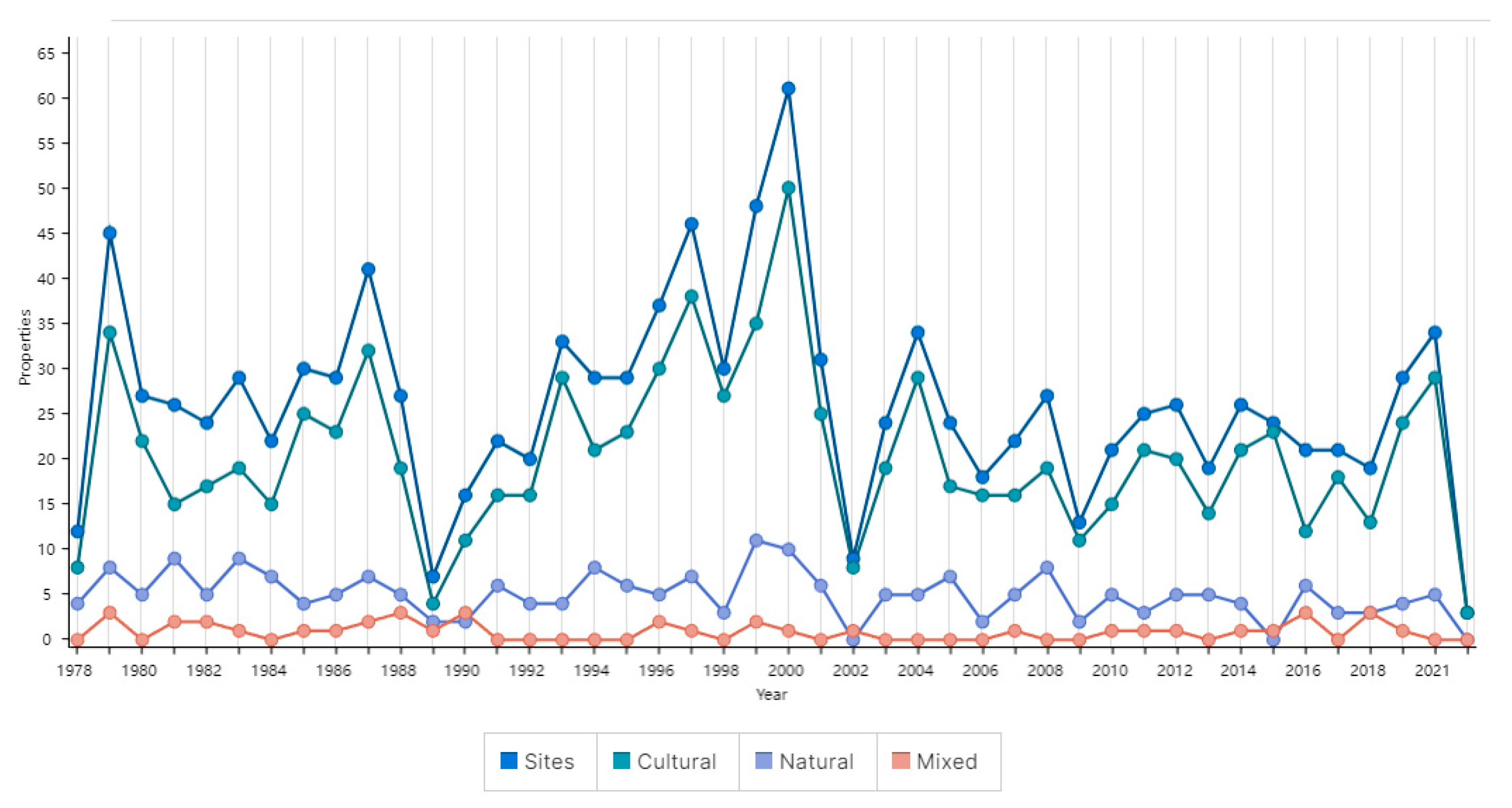

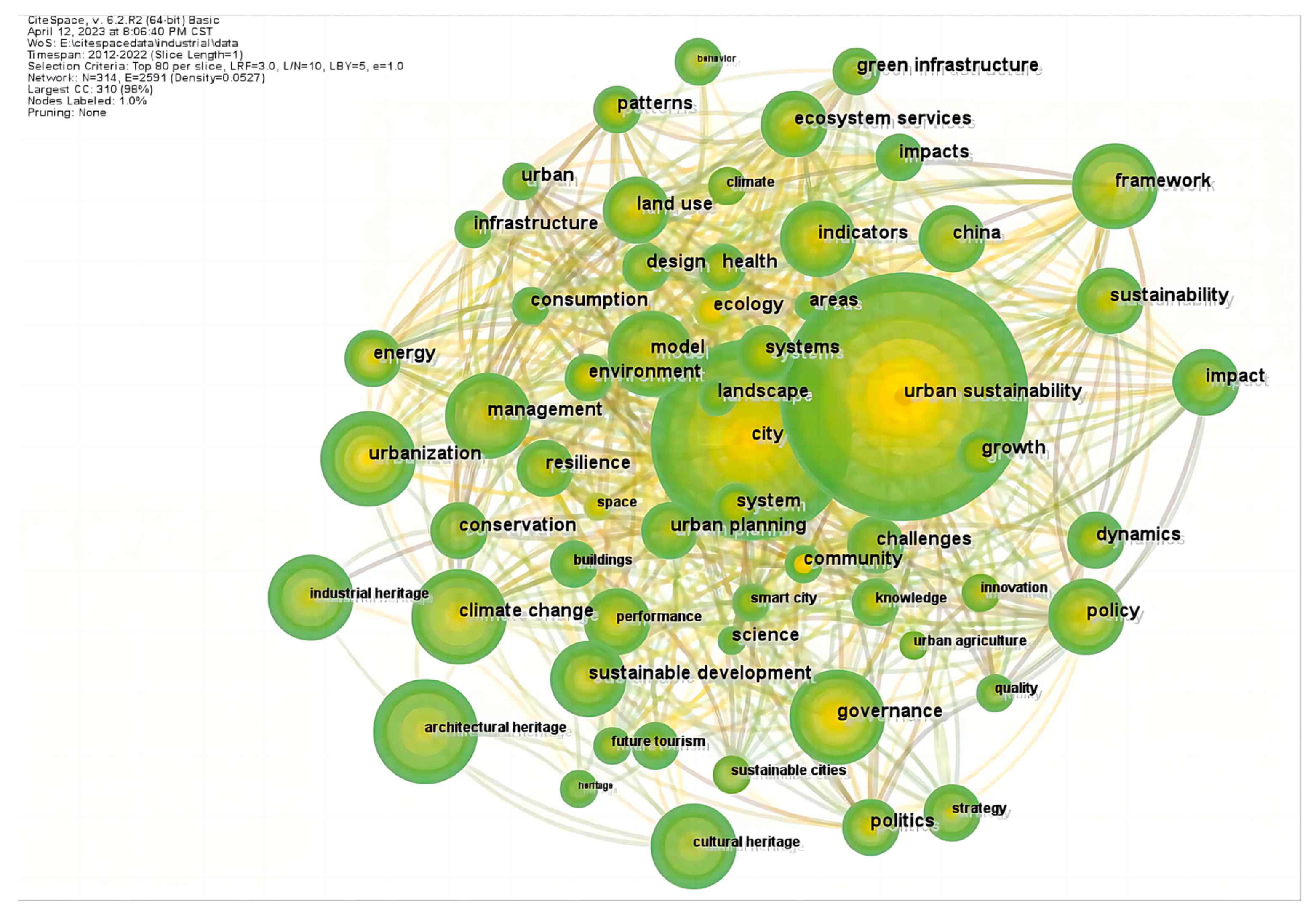
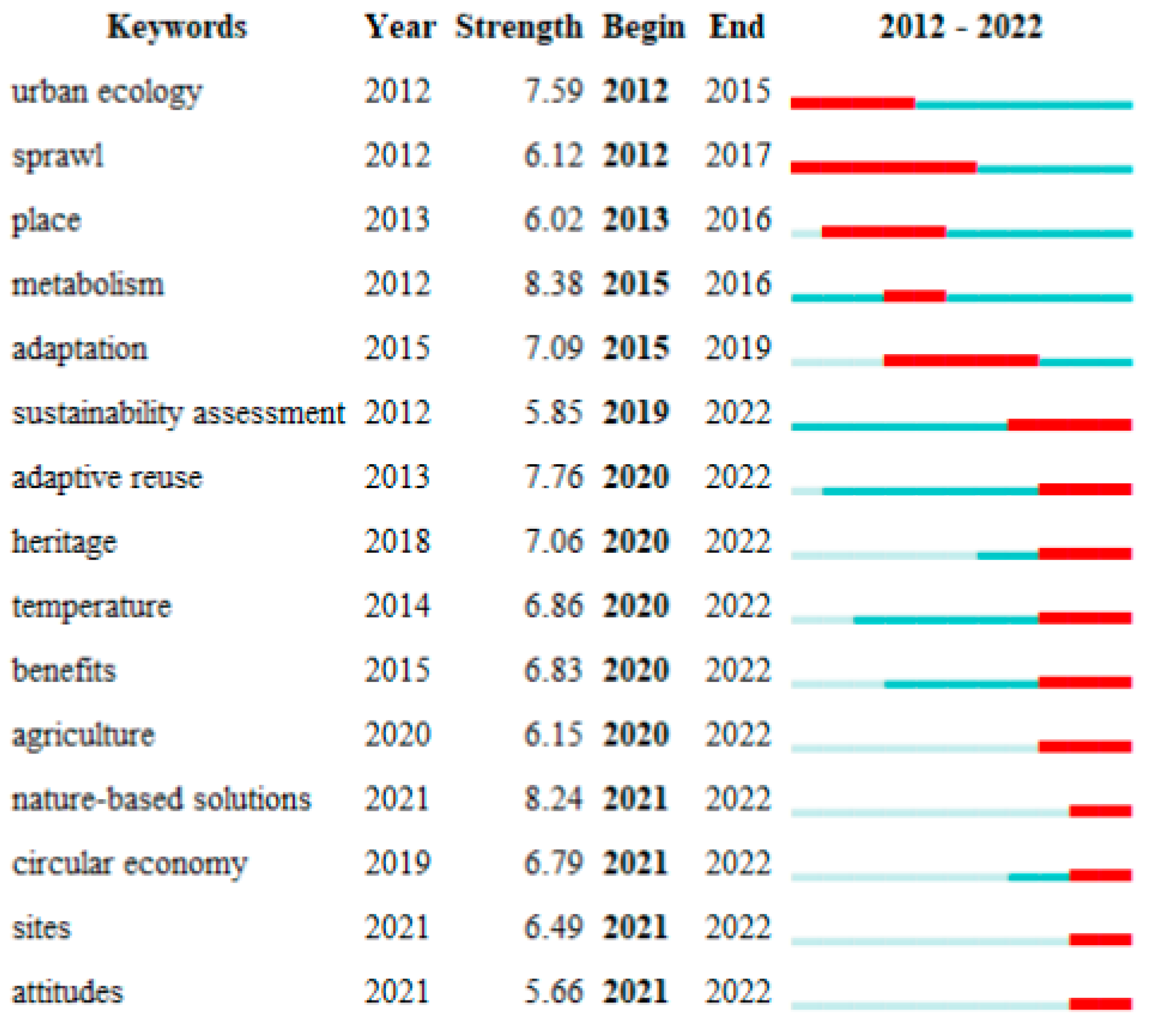

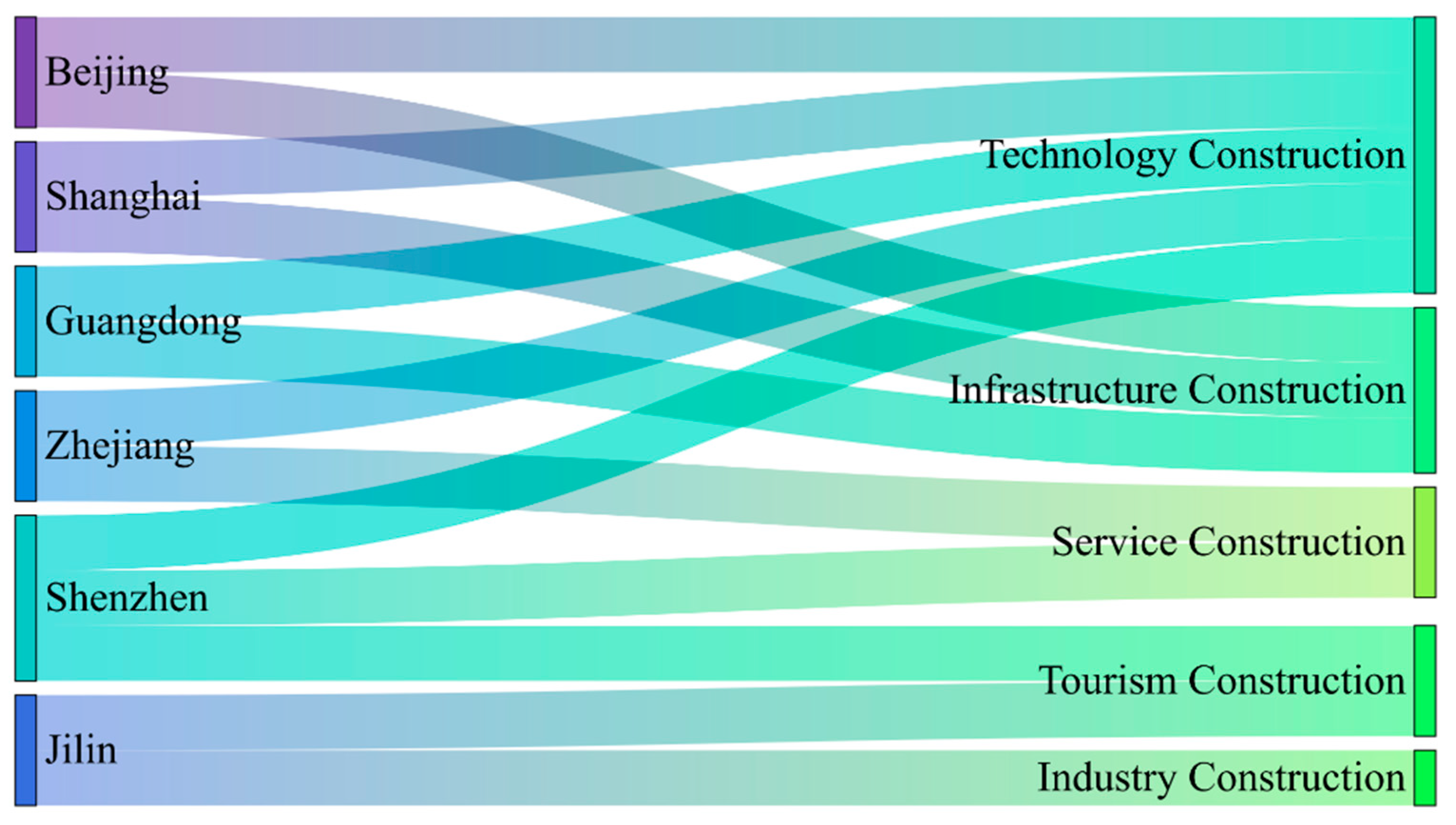
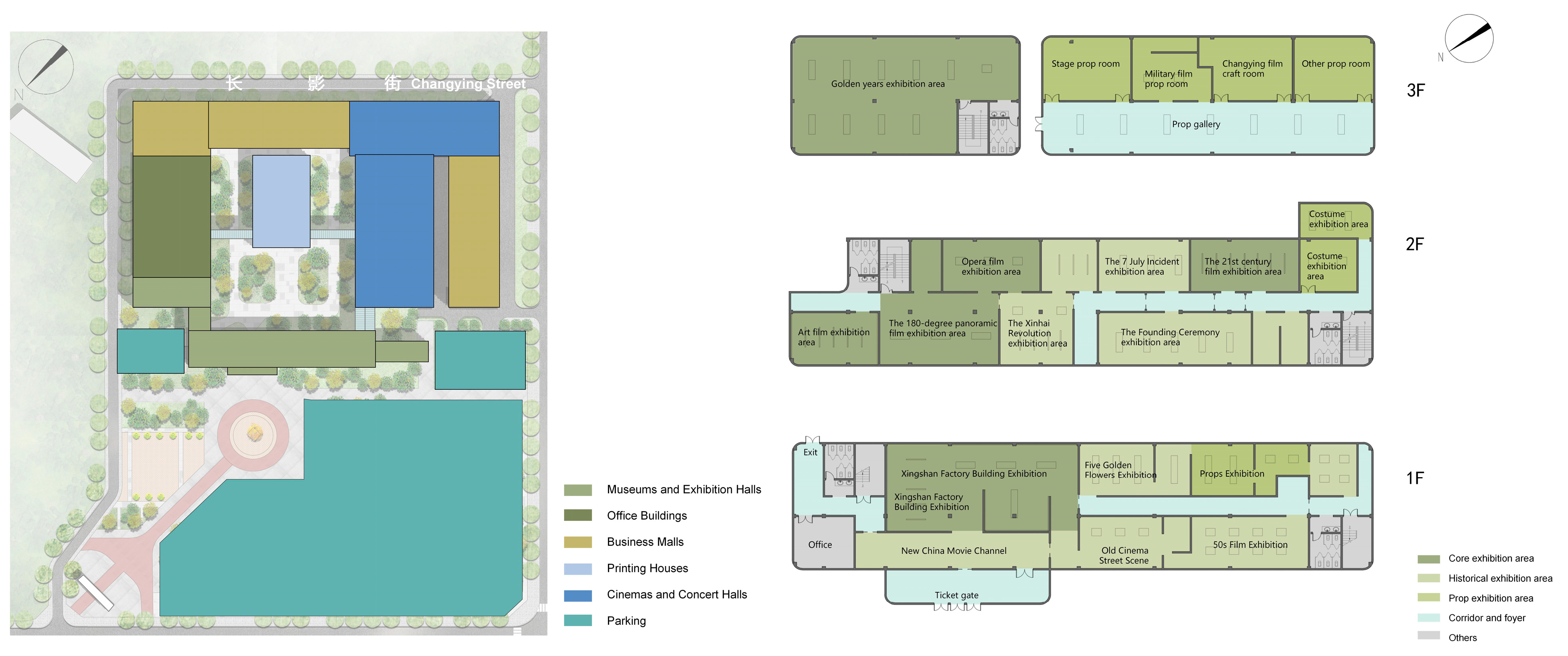

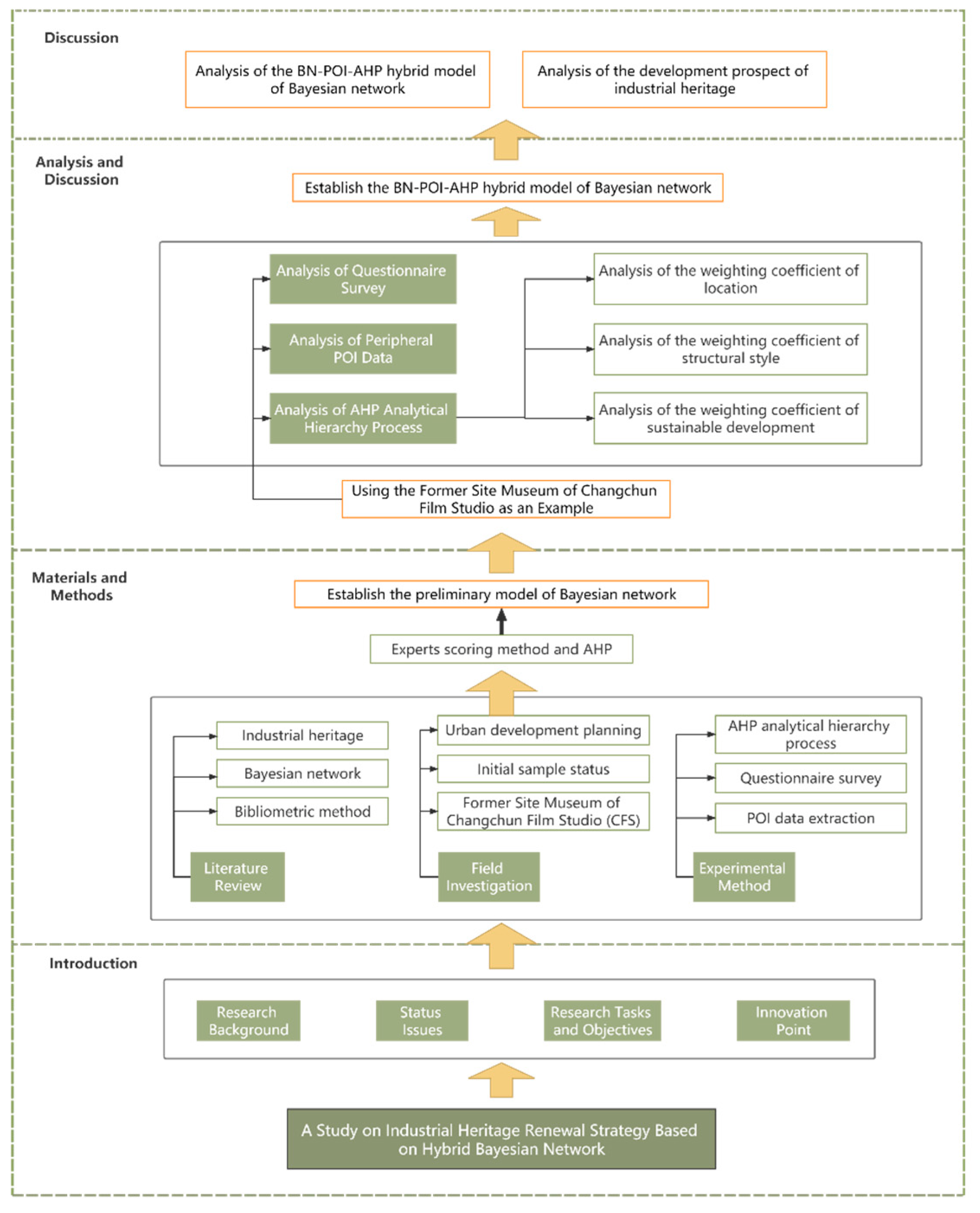
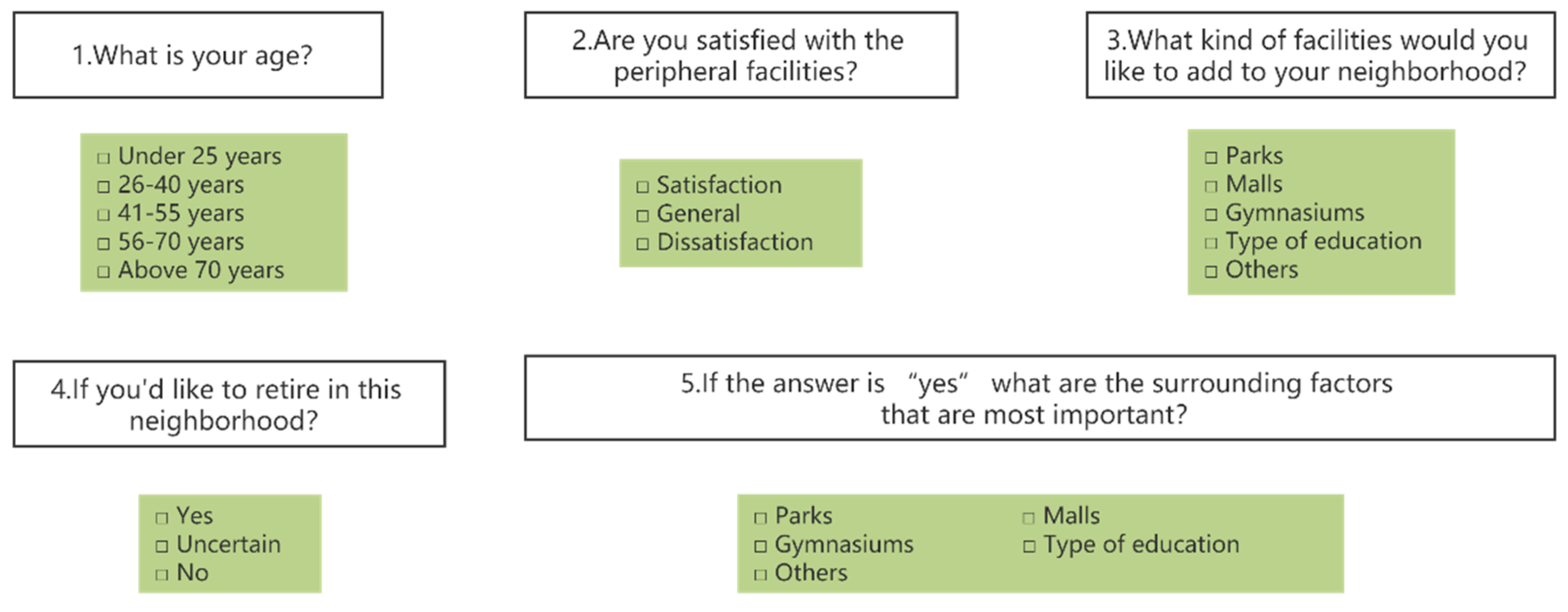
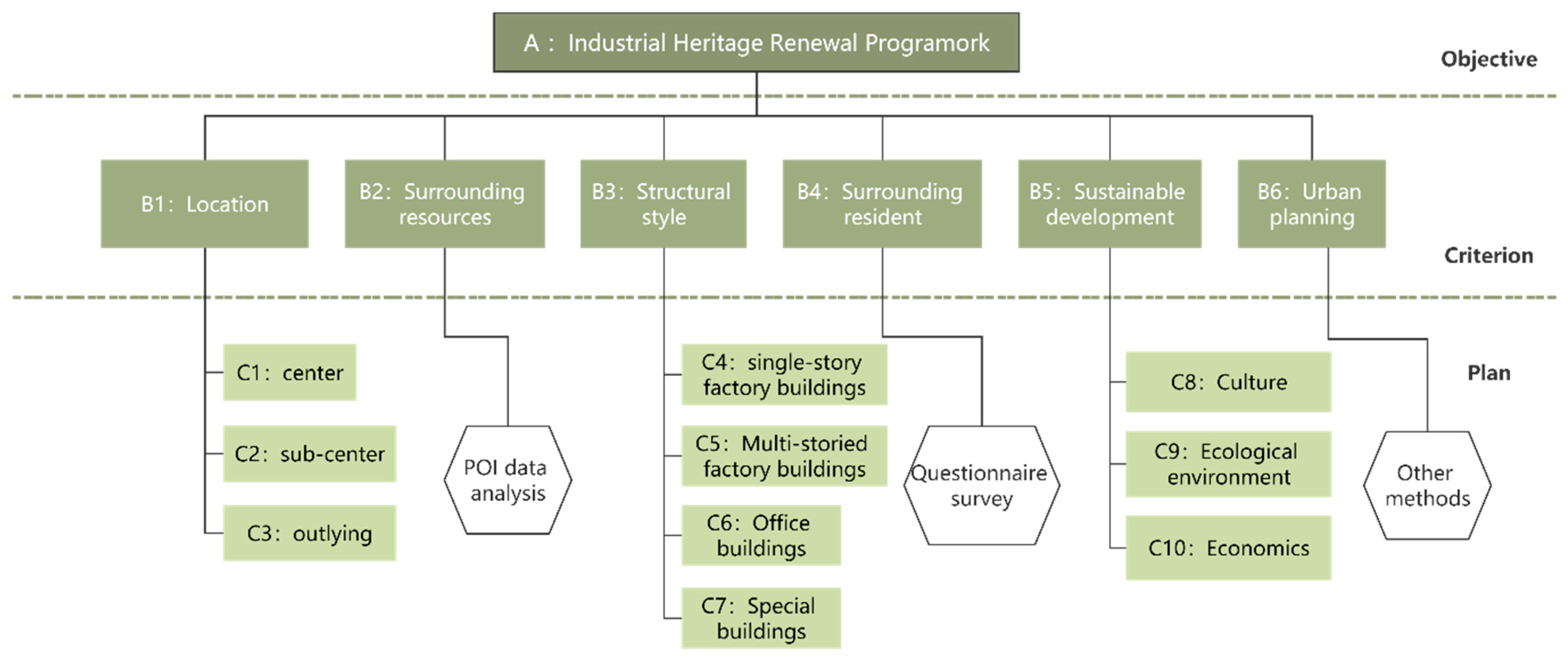
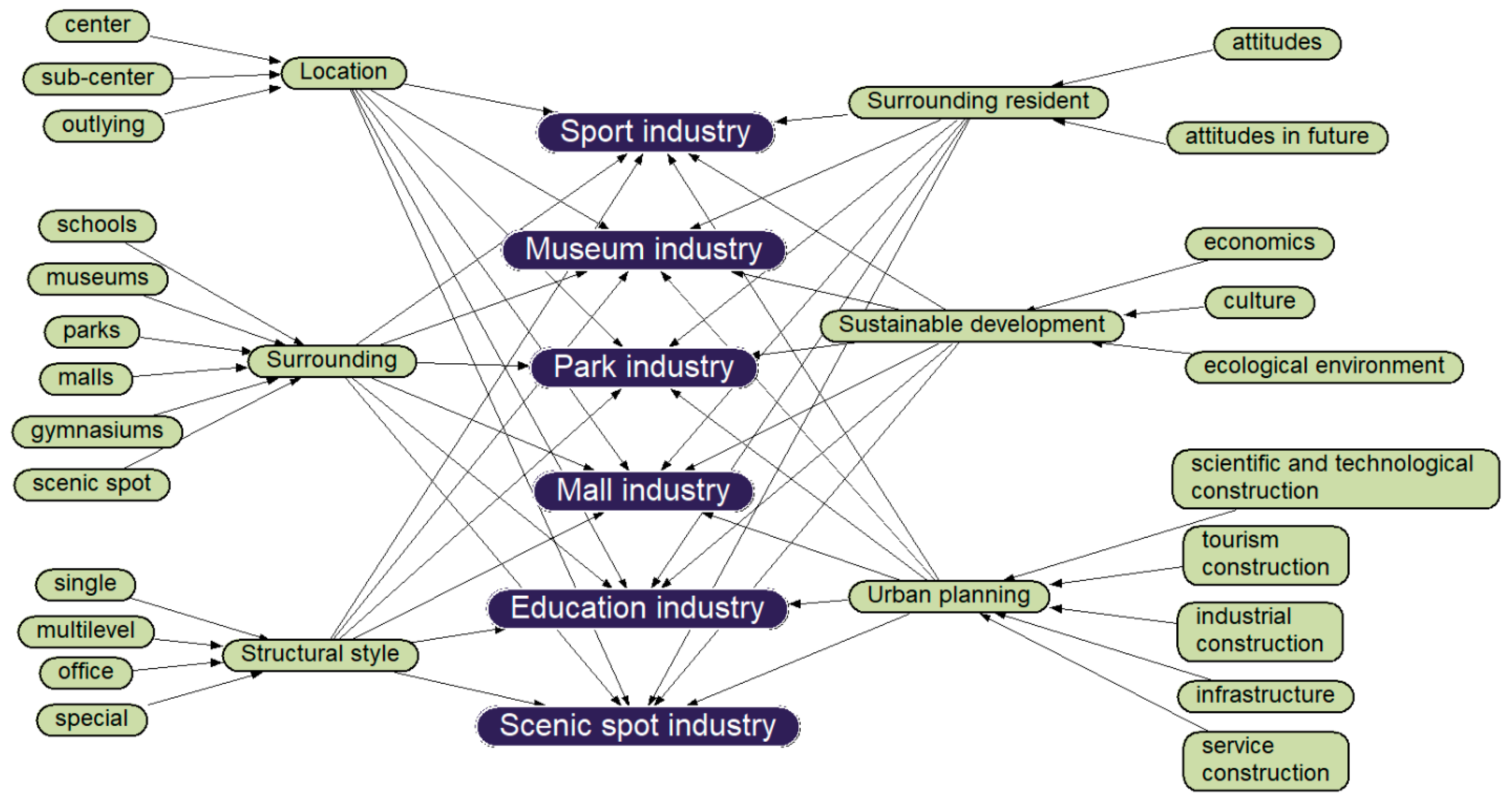
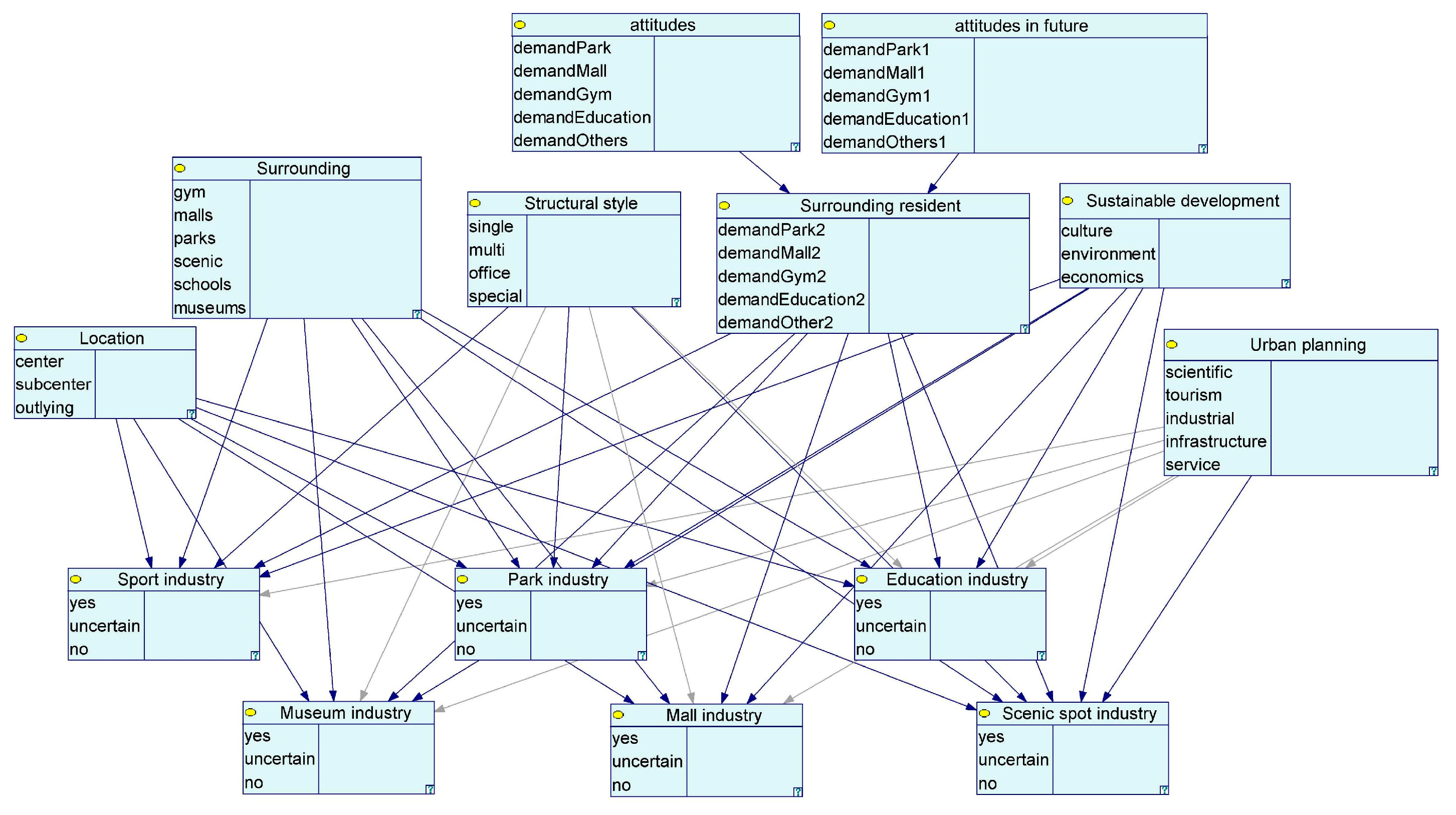

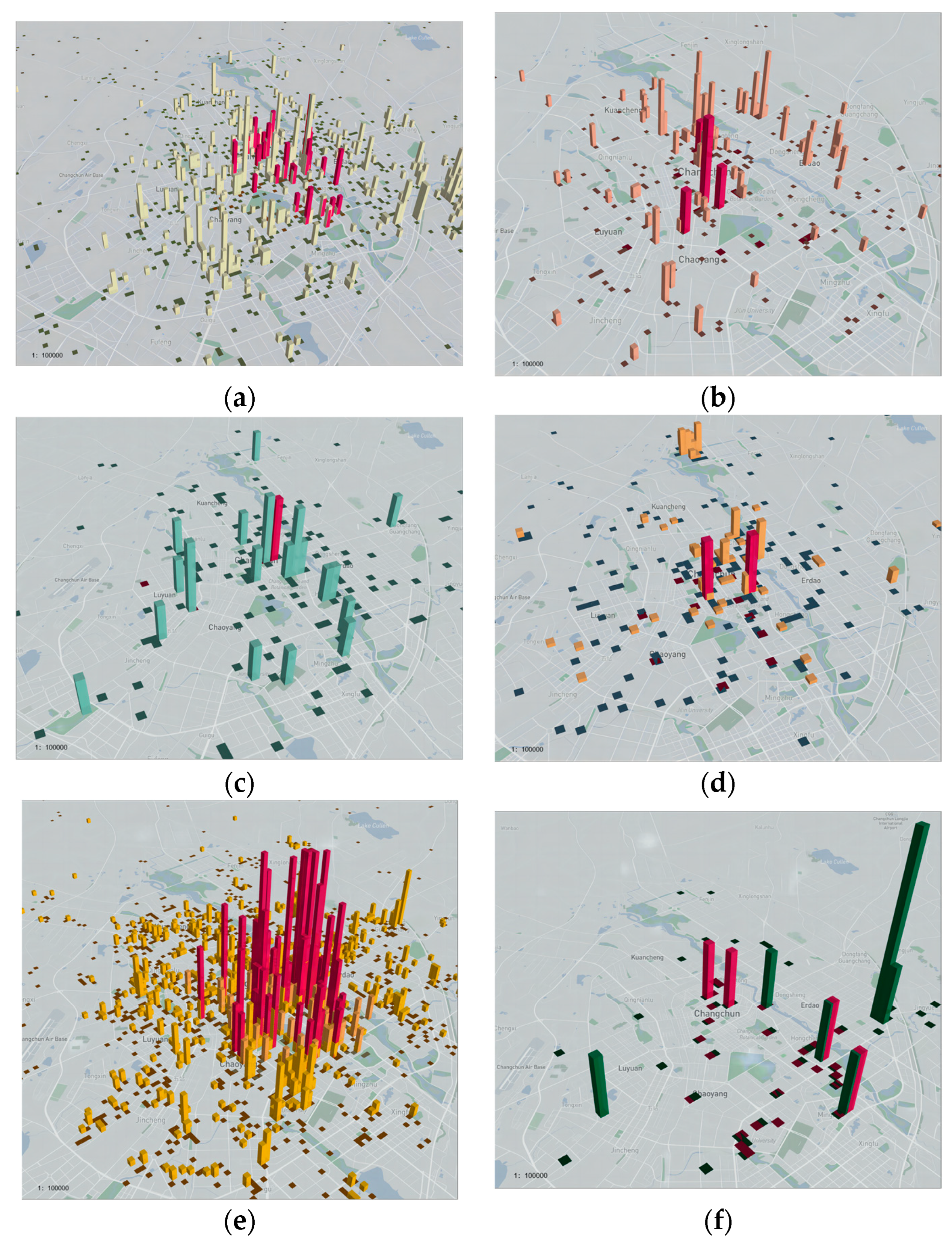
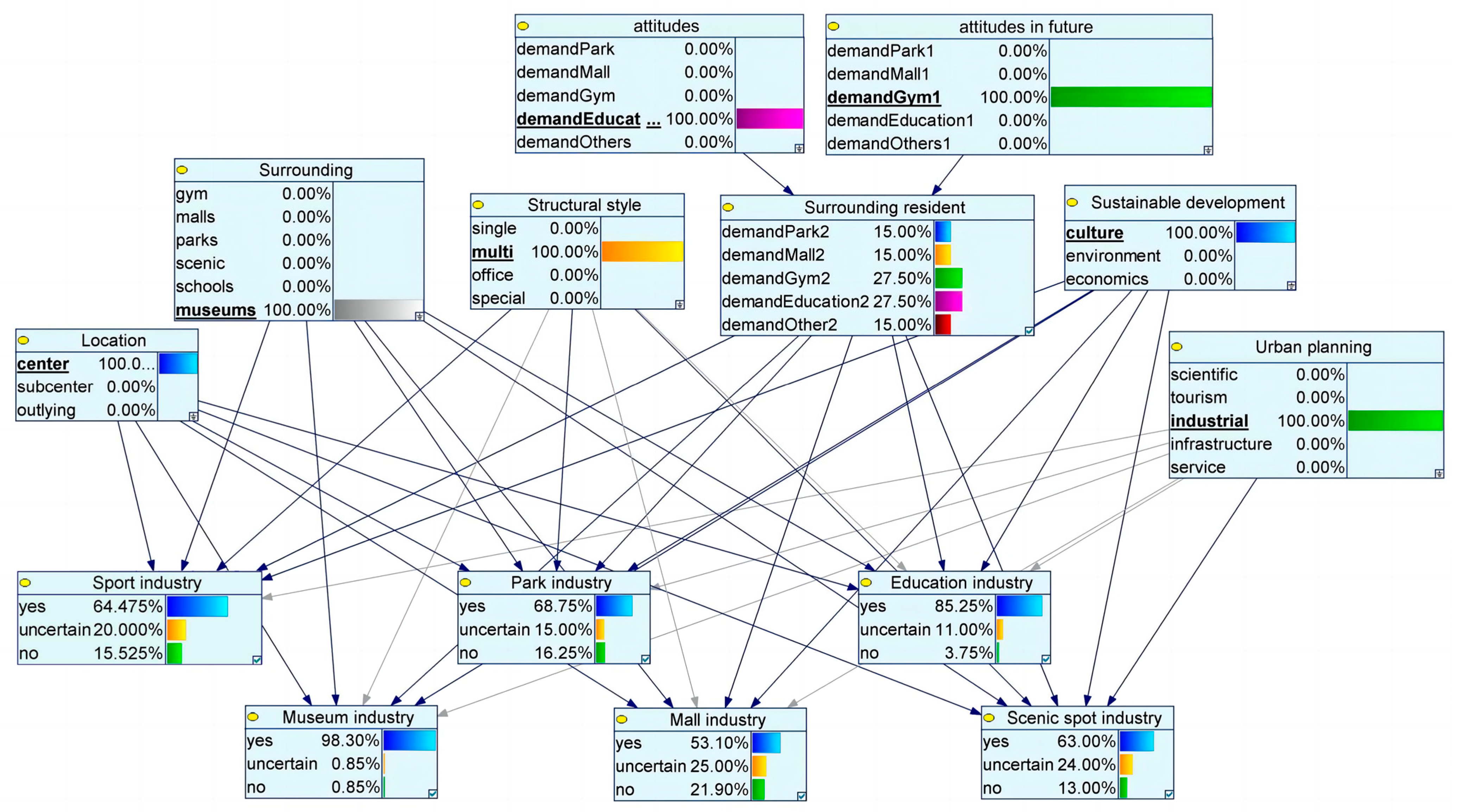

| Research Direction | Literature | Year | Method or Technology |
|---|---|---|---|
| Research on Conservation Methods | Heritage Building Conservation in Malaysia: Experience and Challenges [8] | 2011 | Does not have |
| Historic preservation, GIS, and rural development: The case of Almería province, Spain [9] | 2013 | Geographic Information System | |
| Impact on society and the environment | Developers, regeneration and sustainability issues in the reuse of vacant industrial buildings [10] | 1999 | Does not have |
| New uses for old traditional farm buildings: The case of the underground wine cellars in Spain [11] | 2009 | Does not have | |
| Impacts of the Revitalizing Industrial Buildings (RIB) Scheme in Hong Kong [12] | 2015 | Questionnaire survey | |
| Influential factors of Industrial Heritage Development | Historic Buildings and Rehabilitation Expenditures: A Panel Data Approach [13] | 2006 | Hedonic model |
| Correlations Between Public Appreciation of Historical Building and Intention to Visit Heritage Building Reused as Retail Store [14] | 2015 | Questionnaire survey | |
| Critical sustainable development factors in the adaptive reuse of urban industrial buildings. A fuzzy DEMATEL approach [15] | 2019 | Fuzzy DEMATEL approach | |
| The Strategy of Industrial Heritage Renewal | Designing Adaptive Reuse Strategies for Cultural Heritage with Choice Experiments [16] | 2017 | Choice Experiments |
| Ranking of Adaptive Reuse Strategies for Abandoned Industrial Heritage in Vulnerable Contexts: A Multiple Criteria Decision Aiding Approach [17] | 2019 | A multicriteria decision aiding approach |
| Literature | Influential Factors | |||||
|---|---|---|---|---|---|---|
| Location | Surrounding Resources | Urban Planning | Surrounding Resident | Sustainable Development | Structural Style | |
| Jie Chen (2016) [17] | ◎ | ◎ | ||||
| Vardopoulos I (2019) [15] | ◎ | ◎ | ◎ | |||
| Marta Bottero (2019) [18] | ◎ | ◎ | ◎ | |||
| Liu Yu (2015) [19] | ◎ | ◎ | ◎ | |||
| Xosé Somoza-Medina (2021) [20] | ◎ | ◎ | ◎ | |||
| Liu Na (2023) [21] | ◎ | ◎ | ◎ | ◎ | ||
| Set | Search Query and Results | Results |
|---|---|---|
| #5 | #1 OR #2 OR #3 OR #4 | 4595 |
| #4 | “Industrial Heritage” (All Fields) and English (Language) and Article OR Review (Document Type) | 389 |
| #3 | “Heritage Protection” (All Fields) and English (Language) and Article OR Review (Document Type) | 480 |
| #2 | “Urban Sustainability” (All Fields) and English (Language) and Article OR Review (Document Type) | 2953 |
| #1 | “Architectural Heritage” (All Fields) and English (Language) and Article OR Review (Document Type) | 972 |
| Category | Detailed Content |
|---|---|
| Sport | Including sports venues, fitness centers, swimming pools, and courts related to sports and leisure services under the category of Sports. |
| Mall | Including shopping centers, specialty shopping streets, and shopping complex-related establishments under the category of Mall. |
| Park | Including parks and squares under the category of Scenic Spot. |
| Scenic Spot | Including scenic spots and their related places under the category of Scenic Spot. |
| Education | Including schools and their related places under the categories of Science and Technology and Cultural Services. |
| Museum | Including museums, planetariums, art galleries, art centers, science and technology museums, exhibition halls, and related places under the categories of Science and Technology and Cultural Services. |
| Project Name | Huairou Science City | Shijing Sports Industrial Park | Fanshan Industrial Heritage Town | Yangcheng Creative Industrial Park | Shekou Value Factory |
|---|---|---|---|---|---|
| Location | Beijing | Shanghai | Wenzhou | Guangzhou | Shenzhen |
| Peripheral sports | 43 | 328 | 2 | 310 | 117 |
| Citywide Sports | 6754 | 2452 | 2110 | 4514 | 4933 |
| Percentage (P1) | 0.64% | 13.38% | 0.09% | 6.87% | 2.37% |
| Peripheral malls | 1 | 50 | 1 | 100 | 19 |
| Citywide malls | 1308 | 1213 | 460 | 1378 | 1091 |
| Percentage (P2) | 0.08% | 4.12% | 0.22% | 7.26% | 1.74% |
| Peripheral parks | 10 | 43 | 2 | 49 | 48 |
| Citywide parks | 2189 | 1252 | 792 | 1304 | 1254 |
| Percentage (P3) | 0.46% | 3.43% | 0.25% | 3.76% | 3.83% |
| Peripheral scenic spots | 25 | 95 | 21 | 171 | 50 |
| Citywide scenic spots | 9243 | 5561 | 3918 | 4463 | 2667 |
| Percentage (P4) | 0.27% | 1.71% | 0.54% | 3.83% | 1.87% |
| Peripheral educations | 205 | 150 | 4 | 489 | 53 |
| Citywide education | 14439 | 6863 | 4567 | 7357 | 7210 |
| Percentage (P5) | 1.42% | 2.19% | 0.09% | 6.65% | 0.74% |
| Peripheral museums | 9 | 90 | 4 | 75 | 15 |
| Citywide museums | 2710 | 1572 | 1017 | 1078 | 774 |
| Percentage (P6) | 0.33% | 5.73% | 0.39% | 6.96% | 1.94% |
| Project Name | Huairou Science City | Shijing Sports Industrial Park | Fanshan Industrial Heritage Town | Yangcheng Creative Industrial Park | Shekou Value Factory |
|---|---|---|---|---|---|
| Percentage (P1) | 0.0064 | 0.1338 | −0.0013 | 0.0687 | 0.0237 |
| Deviation Average (Di) | 0.0018 | 0.0901 | 0.0009 | 0.0182 | 0.0059 |
| Percentage (P1) | 0.0240 | 0.0412 | −0.0001 | 0.0726 | 0.0174 |
| Deviation Average (Di) | −0.0038 | −0.0024 | 0.0022 | 0.0221 | −0.0004 |
| Percentage (P1) | 0.1431 | 0.0343 | 0.0003 | 0.0376 | 0.0383 |
| Deviation Average (Di) | 0.0000 | −0.0093 | 0.0025 | −0.0129 | 0.0204 |
| Percentage (P1) | 0.0847 | 0.0171 | 0.0031 | 0.0383 | 0.0187 |
| Deviation Average (Di) | −0.0019 | −0.0266 | 0.0054 | −0.0121 | 0.0009 |
| Percentage (P1) | 0.4447 | 0.0219 | −0.0014 | 0.0665 | 0.0074 |
| Deviation Average (Di) | 0.0096 | −0.0218 | 0.0009 | 0.0160 | −0.0105 |
| Percentage (P1) | 0.1040 | 0.0573 | 0.0017 | 0.0696 | 0.0194 |
| Deviation Average (Di) | −0.0012 | 0.0136 | 0.0039 | 0.0191 | 0.0015 |
| Mean (M) | 0.0046 | 0.0436 | 0.0023 | 0.0505 | 0.0178 |
| Standard Devistion (σ) | 0.0044 | 0.0400 | 0.0016 | 0.0171 | 0.0097 |
| 2× Standard Devistion (2σ) | ±0.0088 | ±0.0799 | ±0.0033 | ±0.0342 | ±0.0194 |
| 3× Standard Devistion (3σ) | ±0.0132 | ±0.1199 | ±0.0049 | ±0.0513 | ±0.0291 |
| Category | Percentage | Huairou Science City | Shijing Sports Industrial Park | Fanshan Industrial Heritage Town | Yangcheng Creative Industrial Park | Shekou Value Factory |
|---|---|---|---|---|---|---|
| Sport | 0.64% | 13.38% | 0.09% | 6.87% | 2.37% | |
| 19.94% | 43.78% | 5.99% | 19.45% | 18.99% | ||
| Mall | 0.08% | 4.12% | 0.22% | 7.26% | 1.74% | |
| 2.39% | 13.49% | 13.75% | 20.55% | 13.94% | ||
| Park | 0.46% | 3.43% | 0.25% | 3.76% | 3.83% | |
| 14.31% | 11.24% | 15.97% | 10.64% | 30.65% | ||
| Scenic spot | 0.27% | 1.71% | 0.54% | 3.83% | 1.87% | |
| 8.47% | 5.59% | 33.89% | 10.85% | 15.01% | ||
| Education | 1.42% | 2.19% | 0.09% | 6.65% | 0.74% | |
| 44.47% | 7.15% | 5.54% | 18.82% | 5.89% | ||
| Museum | 0.33% | 5.73% | 0.39% | 6.96% | 1.94% | |
| 10.40% | 18.74% | 24.87% | 19.70% | 15.52% |
| Scale | Definition |
|---|---|
| 1 | equal importance |
| 3 | somewhat important |
| 5 | strongly more important |
| 7 | very strongly more important |
| 9 | extremely more important |
| 2, 4, 6, 8 | intermediate values |
| Bayesian Network Model Construction | Concrete Content |
|---|---|
| 1. Data learning methods | The overall structure is built via data learning, and the relevant conditional probability values are produced. |
| 2. Determined by industry experts | Industry professionals decide the topology of the built-in Bayesian network and the establishment of the associated conditional probability values based on experience and in-depth knowledge. |
| 3. A combination of the two above | The general structure of the Bayesian network is built using data learning and the knowledge from experts, and the associated conditional probability values are produced. |
| Group 1 | B1 | B2 | B3 | B4 | B5 | B6 |
|---|---|---|---|---|---|---|
| B1 | 1 | 1/4 | 3 | 1/2 | 1/3 | 1/2 |
| B2 | 4 | 1 | 4 | 3 | 1 | 3 |
| B3 | 1/3 | 1/4 | 1 | 1 | 1 | 1/2 |
| B4 | 2 | 1/4 | 1 | 1 | 1/2 | 1/2 |
| B5 | 3 | 1 | 1 | 2 | 1 | 3 |
| B6 | 2 | 1/3 | 2 | 2 | 1/3 | 1 |
| Group 2 | C1 | C2 | C3 |
|---|---|---|---|
| C1 | 1 | 2 | 5 |
| C2 | 1/2 | 1 | 2 |
| C3 | 1/5 | 1/2 | 1 |
| Group 3 | C4 | C5 | C6 | C7 |
|---|---|---|---|---|
| C4 | 1 | 2 | 4 | 5 |
| C5 | 1/2 | 1 | 2 | 2 |
| C6 | 1/4 | 1/2 | 1 | 1 |
| C7 | 1/5 | 1/2 | 1 | 1 |
| Group 4 | C8 | C9 | C10 |
|---|---|---|---|
| C8 | 1 | 1/2 | 2 |
| C9 | 2 | 1 | 3 |
| C10 | 1/2 | 1/3 | 1 |
| Group 1 | B1 | B2 | B3 | B4 | B5 | B6 | w | Aw |
|---|---|---|---|---|---|---|---|---|
| B1 | 0.08 | 0.08 | 0.25 | 0.05 | 0.08 | 0.06 | 0.1006 | 0.68 |
| B2 | 0.32 | 0.32 | 0.33 | 0.32 | 0.24 | 0.35 | 0.3151 | 2.08 |
| B3 | 0.03 | 0.08 | 0.08 | 0.11 | 0.24 | 0.06 | 0.0993 | 0.63 |
| B4 | 0.16 | 0.08 | 0.08 | 0.11 | 0.12 | 0.06 | 0.1018 | 0.67 |
| B5 | 0.24 | 0.32 | 0.08 | 0.21 | 0.24 | 0.35 | 0.2424 | 1.58 |
| B6 | 0.16 | 0.11 | 0.17 | 0.21 | 0.08 | 0.12 | 0.1409 | 0.93 |
| Group 2 | C1 | C2 | C3 | w | Aw |
|---|---|---|---|---|---|
| C1 | 0.59 | 0.57 | 0.63 | 0.5949 | 1.79 |
| C2 | 0.29 | 0.29 | 0.25 | 0.2766 | 0.83 |
| C3 | 0.12 | 0.14 | 0.13 | 0.1285 | 0.39 |
| Group 3 | C4 | C5 | C6 | C7 | w | Aw |
|---|---|---|---|---|---|---|
| C4 | 0.51 | 0.50 | 0.50 | 0.56 | 0.5171 | 2.08 |
| C5 | 0.26 | 0.25 | 0.25 | 0.22 | 0.2447 | 0.98 |
| C6 | 0.13 | 0.13 | 0.13 | 0.11 | 0.1223 | 0.49 |
| C7 | 0.10 | 0.13 | 0.13 | 0.11 | 0.1159 | 0.46 |
| Group 4 | C8 | C9 | C10 | w | Aw |
|---|---|---|---|---|---|
| C8 | 0.29 | 0.27 | 0.33 | 0.2973 | 0.89 |
| C9 | 0.57 | 0.55 | 0.50 | 0.5390 | 1.62 |
| C10 | 0.14 | 0.18 | 0.17 | 0.1638 | 0.49 |
| Judgment Matrix | Order | CI | CR | Inspection Result | |
|---|---|---|---|---|---|
| Group 1 | 6.570927 | 6 | 0.114 | 0.091 | Satisfying |
| Group 2 | 3.005539 | 3 | 0.003 | 0.005 | Satisfying |
| Group 3 | 4.006232 | 4 | 0.002 | 0.002 | Satisfying |
| Group 4 | 3.009209 | 3 | 0.005 | 0.009 | Satisfying |
| Order | RI |
|---|---|
| 1 | 0.00 |
| 2 | 0.00 |
| 3 | 0.52 |
| 4 | 0.89 |
| 5 | 1.12 |
| 6 | 1.26 |
| Project | Variables | Quantity | Percentage |
|---|---|---|---|
| Age | Under 25 years | 16 | 9.58% |
| 26–40 years | 53 | 31.74% | |
| 41–55 years | 68 | 40.72% | |
| 56–70 years | 24 | 14.37% | |
| Above 71 years | 6 | 3.59% | |
| Peripheral facility satisfaction | Satisfaction | 87 | 52.10% |
| General | 44 | 26.35% | |
| Dissatisfaction | 36 | 21.56% | |
| Demand for peripheral facilities | Parks | 3 | 1.80% |
| Malls | 12 | 7.19% | |
| Gyms | 46 | 27.54% | |
| Type of education | 79 | 47.31% | |
| Others | 27 | 16.17% | |
| Would you like to retire in this neighborhood? | Yes | 95 | 56.89% |
| Uncertain | 32 | 19.16% | |
| No | 40 | 23.95% | |
| If the answer is “yes”, what are the surrounding factors that are most important? | Parks | 51 | 30.54% |
| Malls | 21 | 12.57% | |
| Gyms | 44 | 26.35% | |
| Type of education | 33 | 19.76% | |
| Others | 18 | 10.78% |
| Former Site Museum of Changchun Film Studio | Quantity | Percentage () | Percentage () | Deviation Average (D) | |
|---|---|---|---|---|---|
| Sport | Peripheral | 148 | 3.79% | 5.16% | −0.0846 |
| Citywide | 3912 | ||||
| Mall | Peripheral | 43 | 6.39% | 8.69% | −0.0676 |
| Citywide | 783 | ||||
| Park | Peripheral | 21 | 5.42% | 7.39% | −0.0283 |
| Citywide | 223 | ||||
| Scenic spot | Peripheral | 37 | 5.34% | 7.27% | −0.0627 |
| Citywide | 619 | ||||
| Education | Peripheral | 692 | 15.01% | 20.44% | 0.0276 |
| Citywide | 4610 | ||||
| Museum | Peripheral | 35 | 37.5% | 51.05% | 0.3381 |
| Citywide | 76 | ||||
| Name | Mean (M) | Standard Devistion (σ) | 2× Standard Devistion (2σ) | 3× Standard Devistion (3σ) |
|---|---|---|---|---|
| Data | 0.1225 | 0.1480 | ±0.2961 | ±0.4441 |
Disclaimer/Publisher’s Note: The statements, opinions and data contained in all publications are solely those of the individual author(s) and contributor(s) and not of MDPI and/or the editor(s). MDPI and/or the editor(s) disclaim responsibility for any injury to people or property resulting from any ideas, methods, instructions or products referred to in the content. |
© 2023 by the authors. Licensee MDPI, Basel, Switzerland. This article is an open access article distributed under the terms and conditions of the Creative Commons Attribution (CC BY) license (https://creativecommons.org/licenses/by/4.0/).
Share and Cite
Han, R.; Yang, S. A Study on Industrial Heritage Renewal Strategy Based on Hybrid Bayesian Network. Sustainability 2023, 15, 10707. https://doi.org/10.3390/su151310707
Han R, Yang S. A Study on Industrial Heritage Renewal Strategy Based on Hybrid Bayesian Network. Sustainability. 2023; 15(13):10707. https://doi.org/10.3390/su151310707
Chicago/Turabian StyleHan, Rui, and Shiqi Yang. 2023. "A Study on Industrial Heritage Renewal Strategy Based on Hybrid Bayesian Network" Sustainability 15, no. 13: 10707. https://doi.org/10.3390/su151310707
APA StyleHan, R., & Yang, S. (2023). A Study on Industrial Heritage Renewal Strategy Based on Hybrid Bayesian Network. Sustainability, 15(13), 10707. https://doi.org/10.3390/su151310707









